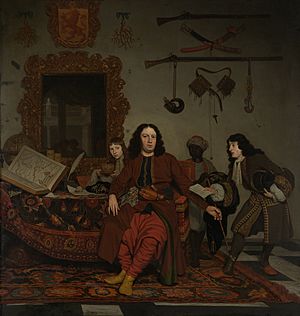Thomas Hees facts for kids
Thomas Hees (born 1634, died 1693) was a Dutch diplomat. He worked for the Dutch government, called the States General. His job was to make peace with groups known as Barbary corsairs. These were pirates from North Africa. Many people know him from his famous painting by Michiel van Musscher. He also kept a diary during his first trip to Algiers.
Contents
Early Life and Studies
Thomas Hees was born in 1634 in Weesp, a town in the Netherlands. His family was wealthy.
When he was 20, he started studying philosophy at the University of Leiden. Four years later, he changed his studies to medicine. He finished his medical training in Angers, France.
In 1660, he came back to the Netherlands. He became a doctor in Amsterdam at the "Collegium Medicum." From 1664 to 1665, he traveled with Jacob Boreel. They went on a special trip to Moscow to meet Czar Alexis I of Russia.
Diplomatic Missions to North Africa
For a long time, Dutch ships faced problems in the Mediterranean Sea. Pirates from Algiers, Tunis, and Tripoli would attack them. These pirates were called Barbary corsairs. They were still under the rule of the Ottoman Sultan. Even though the Dutch had peace agreements with the Ottoman Empire since 1612, the corsairs kept capturing Dutch sailors. Hundreds of sailors were taken as slaves.
The Dutch government fought back with naval attacks. Michiel de Ruyter led three famous missions to the Mediterranean.
In 1674, Algiers decided it was too hard to fight all the European navies. They asked the Dutch government to send someone to talk about peace. Thomas Hees was chosen for this important job.
First Mission to Algiers
Hees went to Algiers in 1675. He had the title of "commissaris," which means commissioner. It took four long years of talks to get a strong peace agreement. Hees wrote all about these difficult negotiations in his diary.
Later Missions
In 1682, Hees went back to Algiers. This time, his goal was to free the remaining Dutch slaves. After that, he traveled to Tunis and Tripoli. He wanted to make peace agreements with those cities too.
Finally, Hees went on a third mission in 1685. This trip was to make sure the existing peace treaties stayed strong. After his career as a diplomat, he settled back in Amsterdam. Thomas Hees died in 1693. He was buried in the Nieuwe Kerk in Amsterdam on September 3 of that year.


